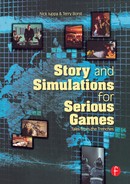1
Who This Book is For
You could be working for an oil company, involved with training workers to operate on offshore oil platforms, and concerned about new security issues in this environment. You could be working for a financial services company, involved with training employees to move into management responsibilities. You could be working for a nongovernmental organization that must train its field workers to contend with broad cultural differences in order to provide relief services and aid to overseas populations. You could be working for a state or county entity that needs to prepare first responders for potential new disaster situations.
In short, you may be involved in some form or manner (however tenuously) with the transfer of training, educational, or pedagogical material to employees or volunteers. In today’s rapidly changing world, these employees and volunteers frequently need new skills, knowledge, and experiences to better compete in the global marketplace, and to respond to new challenges and job demands.
In the past, that transfer might have been handled by more experienced workers conducting walkthroughs for less experienced workers. Or, a workbook or other training materials may have been devised to teach employees new skills. A video illustrating new principles and concepts may have been produced as well.
But in the 21st century, these methodologies have become less effective. For starters, today’s employees have grown up bombarded with media stimuli, and they’re very practiced in tuning out droning lectures, boring print material, and “educational videos.” In addition, the transferable pedagogy has become increasingly complex and nuanced, lending itself less well to traditional learning methods such as rote memorization, multiple choice testing, and watch-the-film-strip-and-get-it. Finally, in the era of mergers and acquisitions, budgets for one-on-one training and workshops with no clear-cut ROI (return on investment) are often slashed or eliminated.
Today’s employees have grown up with fast-paced, immersive, interactive media. Today’s technologies have enabled the relatively inexpensive construction of computer environments offering varying degrees of user immersion, user participation, and “virtual reality.” In short: simulations.
Videogames like Grand Theft Auto and Halo are simulation environments. Very recently, these environments have become a partial basis for the Serious Games movement: videogames designed with serious teaching and training purposes.
You, or your boss, may have heard of these simulations or serious games. Perhaps the competition is already using or creating one. Perhaps budget money is available to build one. Perhaps you’d just like to see if you can reach your employees in more effective ways, and maybe the building of a simulation is the right step for this.
But you’ve never built a simulation or serious game. You do a little research and you find out that when Rockstar Games or Microsoft produces a game, they spend millions and millions of dollars.
And if the task isn’t daunting enough, suddenly your boss says, “Oh yeah, and it should have a story.” Or, perhaps you begin going out to professionals about your nascent simulation project, and sooner or later one of them asks, “What’s the narrative that holds this thing together?”
Now what?
This book is about confronting this challenge, and showing that designing an interactive, story-driven, pedagogical simulation is not as impossible as it might seem.
The origin of this book rests in a remarkable collaboration that took place between Paramount Pictures, USC’s Institute for Creative Technology, and the United States Army. Their intent was to build serious games: interactive, story-driven simulations that would train officers and commanders to handle various crisis situations.
However, the lessons and observations from this collaboration are applicable to the building of serious games in any professional, educational, vocational, or volunteer arena. Given the ubiquity and inexpensiveness of technology and distribution, an organization of almost any size can contemplate the building of a serious game to address training and educational needs.
The first half of this book begins by outlining three major projects that Hollywood created for the United States Military. These projects were expressly designed to place storytelling at the heart of the simulation. This first half will then take a broader look at what constitutes story and character, and how these components can be successfully integrated into a teaching experience, while reviewing the design principles and the paradigms developed in the Hollywood/military collaboration. We’ll move on to how the instructor is incorporated into a training simulation, and how automated story generation may assist in the replayability of simulation scenarios.
The second half of this book examines the design and building of these projects: how scripts are created; how gameplay is selected; how pedagogical design and assessment fits in; and how media, gameplay, and story will drive the selection of media and platforms. The book will look at different types of simulations and offer techniques on how to maximize user immersion and interactivity, even when a budget is small and personnel scarce. Returning to how story fits into simulation environments, we’ll examine the uses of story narrative in commercial games and serious games, and gaze into the crystal ball on how story will fit into different platforms and environments in the future. The hope is that the lessons learned will benefit all training designs, and encourage instructional designers, game companies, and developers of entertainment software to begin exploring this new convergence of story and simulation and its enormous potential.
You may be a project manager, an executive, a training leader, a subject matter expert, a personnel director, a professor, a fundraiser, a military officer, a government official, a regional office manager, a researcher, a textbook writer, or just someone who would like to know how to move beyond exam blue books and PowerPoint slideshows. In the following pages, we’ll suggest ways that you can.
